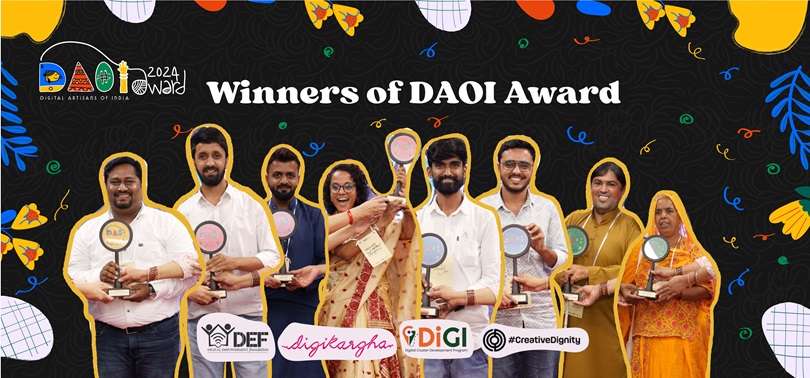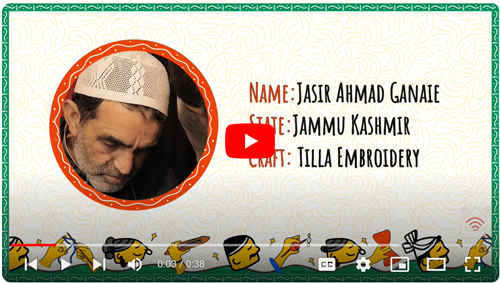
July, 2024

Digital Artisans of India: Stories of Creativity, Tradition, Resilience and Love
India’s artisan community, numbering over 200 million, surpasses the population of all but six countries worldwide. This vast republic of artisans constitutes a pillar of India’s cultural and economic heritage, enriching traditions through diverse crafts and practices. The handloom industry, with 23.77 lakh looms and employing 3,522,512 workers, predominantly women, underscores its significance as the largest cottage industry. Valued at Rs 24,300 crores, Indian handicrafts contribute 14% to industrial production, 4% to GDP, and 13% to export earnings, with fabrics like ikat driving global appeal. Across 470 clusters in states such as Uttar Pradesh, Tamil Nadu, Orissa, and West Bengal, these artisans weave intricate narratives into every piece. The sector supports 68.86 lakh artisans, striving amidst challenges like access to working capital. Read more

Expert Says
Post Covid-19, economic recovery across various industries is estimated to be long and hard. Given its self-organised nature, the artisan sector has been rather badly hit. Read More

About Digital Artisans of India 2023-2024
The vibrancy in the traditional Indian textiles had always been attributed to diversity, with each region bringing their own colors, patterns, and techniques. A further extension of this was seen in modern times, as many found contemporary and sustainable means to contribute to the handloom and handicraft industry. Each expansive and diverse aspect, be it old or new, durable or innovative, experimental or a perfection of traditional techniques, brought in its own beauty and made it more exuberant, inclusive, and relevant to changing times. Read more

Stories of Creativity, Tradition, Resilience and Love


Tilla Embroidery’s Heritage and its Reimagination by Craftick
Craftick, a brand established in 2014, represents an evolution in the domain of traditional Tilla embroidery, a craft rooted in the cultural heritage of Kashmir, a craft native to its citizens, a craft that adorns and reflects the beauty of Kashmir in each metallic thread. The brand’s inception is closely tied to the legacy of Jasir’s father, a master craftsman with over thirty-five years of experience in Tilla work. This intricate form of hand embroidery, known for its use of silver and gold metallic threads on luxurious fabrics such as Pashmina shawls, has long been emblematic of Kashmiri artistry. Read more


Amrapari Empowering the Women of Char-Chapori through Sustainable Livelihoods
Amrapari (We Can) is a women’s collective established during the COVID-19 pandemic to create sustainable livelihoods for char-chapori women in Assam. These women, many of whom were daily wage earners working in fisheries, agriculture, and brick kilns, found themselves suddenly without work due to the lockdown. Their marginalised condition was further exacerbated by severe food insecurity, compounded by multiple spates of floods. The collective was founded by Manjuwara Mullah, a women’s rights activist and longtime community worker in Assam’s Barpeta district. Amrapari aims to support women’s empowerment and economic self-sufficiency by assisting them in creating and selling embroidered quilts, a traditional craft of the char-chapori women. Read more


Sustaining and Expanding the Legacy of the Traditional Rogan Art
Jabbar Khatri, a skilled artisan from Nirona in Kutch, Gujarat, is dedicated to preserving the traditional Rogan art, a craft that has been passed down through generations in his family. This intricate art form, which involves painting on fabric using a thick paste made from castor oil and natural pigments, was taught to him by his father, Shri Khatri Arab Hasam, and his uncle, Padamshree Khatri Abdugafur Daud. Both men were renowned practitioners of Rogan art, and their legacy continues through Jabbar’s work. Read more


Tholu Bommalata: From Traditional Puppetry to Contemporary Design Innovation
Tholu Bommalata, a traditional leather puppetry art from Nimmalakunta, Andhra Pradesh, has undergone a transformation, evolving into modern interior design. This art form involves creating intricate items from goat leather, utilising natural dyes and traditional tools. Artisans in Nimmalakunta use these techniques to produce a variety of decorative items, including lifelike lampshades, paintings, and wall hangings. Read more


The Digital Transformation of Kutch’s Copper Bell Craft
The copper bell-making tradition of Kutch, primarily upheld by the Muslim Lohar community, is a case study to the enduring relationship between craftspeople and the pastoralist communities they serve. These bells, originally crafted for livestock, have evolved over time to become decorative items for homes, musical instruments, and festive ornaments. This transformation in usage reflects not only the versatility of the bells but also the adaptability of the craftsmen. Read more


Reviving Chitrakathi and Bringing it to the Life, Today
Chitrakathi is an ancient folk art tradition that dates back to the 17th century in Maharashtra, India. Originating from the village of Pinguli, Chitrakathi combines storytelling with beautiful paintings to bring tales to life. This unique art form has been passed down through generations, keeping the culture and history of the region alive. Read more


The Story of the Siddi Community and their Quilting Legacy
Anitha N, an artist and curator based in Bengaluru, who works within the traditional textiles skills with the Siddi community in northern Karnataka. Over the past eight years, she has worked closely with Siddi women, focusing on the revival of the ancient quilting art known as kavands. This collaboration has been both an artistic and economic empowerment for these women, who have gained recognition for their craftsmanship through Anitha’s efforts. Read more


Kashmir, from the Special Hands of Tariq Ahmad Mir
Tariq Ahmad Mir, the founder of Special Hands of Kashmir, who has turned personal adversity into a story of resilience and empowerment. Despite being diagnosed with muscular dystrophy at a young age, Tariq has not only overcome significant physical challenges but has also emerged as a leading figure in the promotion of traditional Kashmiri shawls. His journey, marked by educational achievements and a deep commitment to his craft, serves as an inspiration to many. Read more


The Story of Kala and its Preservation through Collective Efforts
Kalapuri Foundation is a social enterprise founded in 2018 with a mission to revive and promote traditional Indian handicrafts. Understanding the richness of Indian culture and the discrimination that the artisan community faces, Kalapuri is committed to empowering these artisans by providing them with essential training, tools, and access to fair trade practices. Through these initiatives, Kalapuri Foundation aims to ensure that traditional skills are not lost and that artisans are able to earn a sustainable livelihood from their work. Read more


From Tilonia to the World: The Hatheli Way
The SWRC-Barefoot College began its work with crafts in 1974, aiming to integrate traditional crafts into broader community development initiatives. Over time, the craft section of Barefoot College evolved, and in 1992, it became Hatheli Sansthan, an independent registered non-profit society. Their legacy can be traced back to the first Tilonia Bazaar, which was held in 1975 at Triveni Kala Sangam in Delhi. This event, encouraged by notable figures such as Kamaladevi Chattopadhyaya, Pupul Jayakar, and Shona Ray, was pivotal in bringing rural crafts into the spotlight. Read more


Superb Ladakh Weaving and the Tale of Ladakhi Culture
Diskit Dolma, coming to us from Ladakh, is weaving a new story with the ancient art of Aari embroidery through her innovative brand, Superb Ladakh Weaving. Aari embroidery, also known as Jalakdozi, is a handcraft from Kashmir, celebrated for its intricate designs and historical roots tracing back to the Mughal era. She is preserving craft that once adorned royal garments and furnishings. Read more


From Kashmir to the Rest of the World
In Kashmir, Jahangir Bhat is using creative methods of innovation with Aari embroidery, a craft that dates back to the Mughal era. Known locally as Jalakdozi, this embroidery once graced royal garments. Jahangir, with his design education and respect for tradition, is blending these age-old techniques with the understanding of the modern market. Read more


4000 Years of Ajrakh and its Preservation by Artisans
Riyaz Khatri’s exceptional work with Ajrakh, a 4000-year-old hand-block printing tradition from Kutch, Gujarat, has garnered him the Traditional Art category award at the Digital Artisans of India Awards 2023-24. Ajrakh is a time-honored art form that utilizes natural dyes and a meticulous resist dyeing process to create intricate geometric and floral patterns in vibrant hues of indigo, red, black, and white. This art form is deeply rooted in nature, folklore, and Islamic art, reflecting a rich cultural heritage. Read more


Binding Together Threads of Tangaliya Heritage
In the village of Adhoi in Kutch, Gujarat, Jitendra Dhaiyda is working hard to preserve an age-old tradition. As a Tangaliya weaver, Jitendra carries forward a 700-year legacy that has been cherished by his grandfather and father before him. With twelve years of dedicated experience, Jitendra has become a beacon of hope in the revival of Tangaliya art, an intricate weaving tradition once popular within the Bharwad community but faced with decline. Read more


Urwashi Nirala, a Mithila artist from Assam, who stands at the cusp of tradition and modernity through her innovative approach to Mithila Art. Rooted in an ancient tradition known for its vibrant designs and beautiful images, Mithila Art has long been a canvas for depicting cultural symbolism. Urwashi breathes new life into this age-old art form by integrating it with contemporary digital techniques, creating a bridge between the past and the present. Read more


Bidri and its Integration in the Global Map
Taher Siddiqui is a master artisan credited for his dedication to the ancient craft of Bidri art, a tradition with roots tracing back to Persia. Bidri art flourished in Bidar under the Bahamani sultanate during the 14th century, brought to India by Persian artisans. This intricate craft involves creating objects from a copper and zinc alloy and then decorating them with delicate silver inlays, producing items that are both beautiful and historically significant. Read more


The Tradition of Ikat and its Weave
Chandana, a young social entrepreneur, is an anchor in the world of ikat handloom because of her attempt to combine her education with a deep commitment to her ancestral craft. After graduating, she immersed herself in the traditional art of tie and dye weaving, leading a group of 30 families who are engaged in this craft. Chandana’s work is characterised by her dedication to sustainability, as she focuses on producing ikats using natural dyes on cotton, silk, and linen fabrics. Her efforts are not only about preserving traditional weaving techniques but also about innovating with contemporary designs that appeal to modern consumers. Read more


Clay, Small Mirrors and the Intricate Beauty of Lippan Art
Over a decade ago, Majikhan Mutva started his journey to explore Lippan art, a traditional craft from his village. He was the first artist from his village to dive into this art form, facing a lot of backlash and challenges, including limited resources and lack of exposure. Despite these obstacles, Majikhan remained resolute in wanting to understand Lippan Art and promote its beauty. His passion led him to discover the potential of digital tools to enhance and modernise traditional Lippan art, blending craftsmanship with technology in ways that would enhance his skills, his craft and connect him to trends that were being integrated in traditional craft preservation. Read more


Threading Gond with one Digital Swing at a Time
Sukhiram Maravi is an artisan that is working to preserve the intricate artform of Gond painting. This has earned him recognition for his vital role in preserving this endangered tribal art form. Gond painting, with its intricate patterns and vibrant colors, is not only a visual celebration of tribal life but also a crucial repository of the Gond community’s cultural identity. These artworks share the stories of the tribe’s beliefs, traditions, and their connection to nature and wildlife, serving as a historical record for future generations. Read more

Regular Features


Oral Bytes

eChampions




